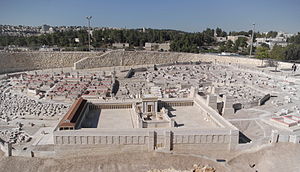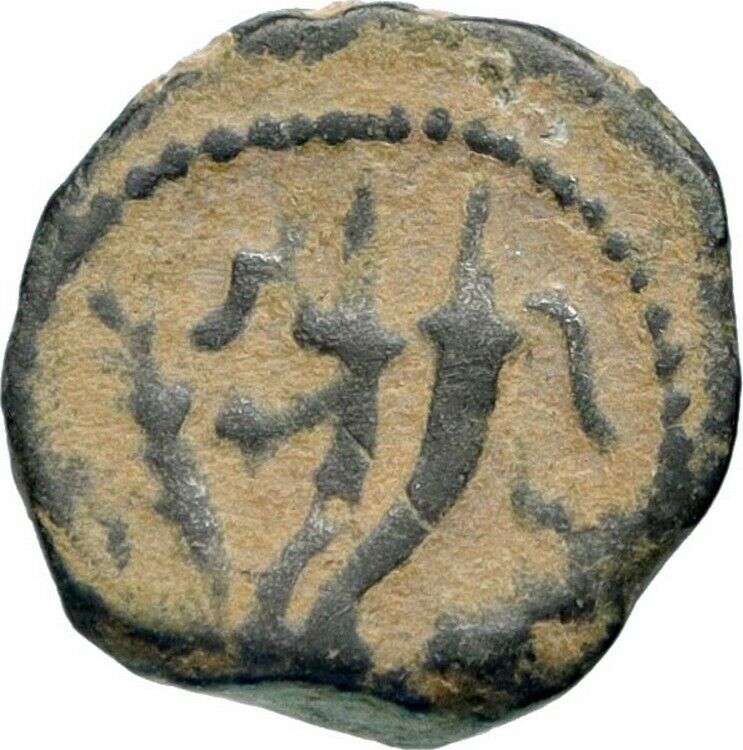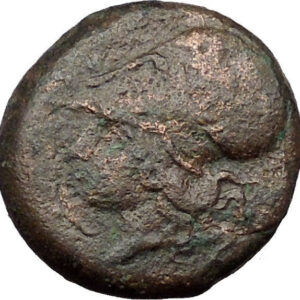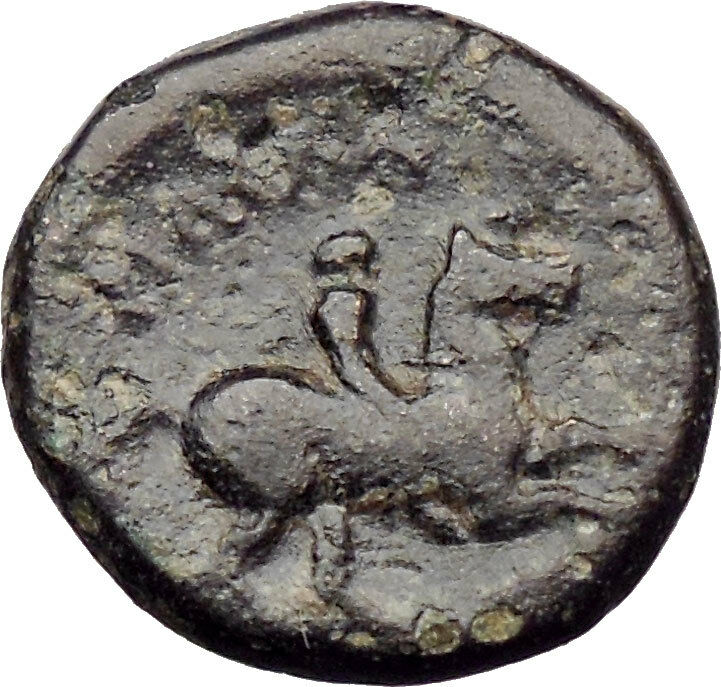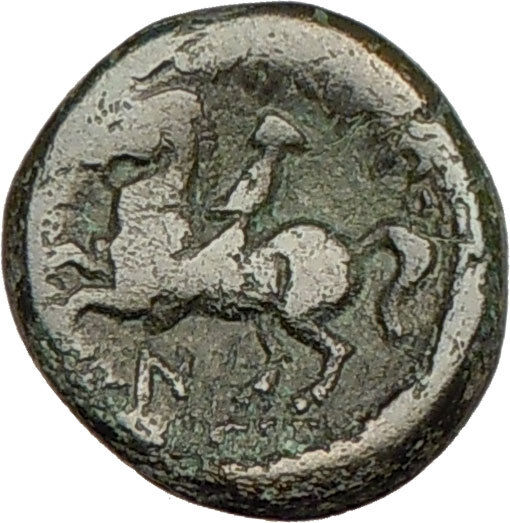|
Jewish Kingdom of Judaea
Herod I, the Great – King: 40-4 B.C.
Bronze 2-prutot 17mm (2.87 grams) of the Samaria mint. Struck year 3, 40 B.C.
Reference: Hendin 1171 (5th Edition)
Poppy on stalk.
HPΩΔΟΥ ΒΑΣΙΛΕΩΣ, winged caduceus flanked by date LΓ (year 3) and TP monogram.
You are bidding on the exact item pictured,
provided with a Certificate of Authenticity and Lifetime Guarantee of
Authenticity.
Herod (Hebrew:
הוֹרְדוֹס, Hordos,
Greek
: Ἡρῴδης,
Hērōidēs), also known as Herod I

or
Herod the Great (born 71, 73 or 74
BCE
, died 4 BCE in
Jericho
, according to other data, 1 BCE), was
an
Edomite
Jewish
Roman
client king
of the Roman provinces of
Judea
,
Galilee
and
Samaria
(present-day
Israel
). He was described as “a madman who
murdered his own family and a great many
rabbis
.” He is also known for his colossal
building projects in
Jerusalem
and other parts of the ancient world,
including the rebuilding of the
Second Temple
in Jerusalem, sometimes referred
to as
Herod’s Temple
. Some details of his biography
can be gleaned from the works of the 1st century CE Roman-Jewish historian
Josephus Flavius
.
His son
Herod Archelaus
was made
ethnarch
of
Samaria
,
Judea
, and
Edom from 4 BCE to 6 CE. He was judged incompetent by
Augustus
who then made Herod’s other son
Herod Antipas
ruler of
Galilee
from 6 CE – 39 CE.
Biography
Herod was born around 74 BCE. He was the second son of
Antipater the Idumaean
, a high-ranked official
under Ethnarch
Hyrcanus II
, and Cypros, a
Nabatean
. A loyal supporter of Hyrcanus II,
Antipater appointed Herod
governor
of
Galilee
at 25, and his elder brother,
Phasael
, governor of Jerusalem. He enjoyed the
backing of Rome but his excessive brutality was condemned by the
Sanhedrin
.
In 43 BCE, following the chaos caused by Antipater offering
financial support to
Caesar’s murderers
, Antipater was poisoned.
Herod, backed by the Roman Army, executed his father’s murderer.
After the
battle of Philippi
towards the end of 42 BCE,
he convinced
Mark Antony
and
Octavian
that his father had been forced to
help Caesar’s murderers. After Antony marched into Asia, Herod was named
tetrarch
of Galilee by the Romans. However, as
Herod’s family had converted to Judaism, his religious commitment had come into
question by some elements of Jewish society. When the
Maccabean
John Hyrcanus
conquered the region of Idumaea
(the Edom
of the
Hebrew Bible
) in 140–130 BCE, he required all
Idumaeans to obey
Jewish law
or to leave; most Idumaeans thus
converted to Judaism
, which meant that they had to be
circumcised
. While King Herod publicly
identified himself as a Jew and was considered as such by some, this religious
identification was undermined by the decadent lifestyle of the
Herodians
, which would have earned them the
antipathy of observant Jews.
Two years later
Antigonus
, Hyrcanus’ nephew, took the throne
from his uncle with the help of the
Parthians
. Herod fled to Rome to plead with the
Romans to restore him to power. There he was elected “King
of the Jews” by the
Roman Senate
. Josephus puts this in the year of
the consulship
of
Calvinus
and
Pollio
(40 BCE), but
Appian
places it in 39 BCE. Herod went back to
Israel to win his kingdom from Antigonus and at the same time he married the
teenage niece of Antigonus,
Mariamne
(known as Mariamne I), in an attempt
to secure a claim to the throne and gain some Jewish favor. However, Herod
already had a wife, Doris, and a three-year-old son,
Antipater
, and chose therefore to banish Doris
and her child.
Three years later, Herod and the Romans finally captured
Jerusalem and executed Antigonus. Herod took the role as sole ruler of Israel
and the title of
basileus
(Gr. Βασιλευς, king) for himself,
ushering in the
Herodian Dynasty
and ending the
Hasmonean Dynasty
. Josephus reports this as
being in the year of the consulship of
Agrippa
and
Gallus
(37 BCE), but also says that it was
exactly 27 years after Jerusalem fell to
Pompey
, which would indicate 36 BCE. (Cassius
Dio also reports that in 37 “the Romans accomplished nothing worthy
of note” in the area.) According to Josephus, he ruled for 37 years, 34 years of
them after capturing Jerusalem.
Herod later executed several members of his own family,
including his wife Mariamne. A summary of the rest of his life can be found in
the
Chronology
section below.
Architectural
achievements
Herod’s most famous and ambitious project was the expansion
of the
Second Temple
in Jerusalem.
In the eighteenth year of his reign (20–19 BCE), Herod
rebuilt the Temple on “a more magnificent scale”. The new Temple was finished in
a year and a half, although work on out-buildings and courts continued another
eighty years. To comply with religious law, Herod employed 1,000 priests as
masons and carpenters in the rebuilding. The finished temple, which was
destroyed in 70 CE, is sometimes referred to as
Herod’s Temple
. Today, only the four retaining
walls remain standing, including the
Wailing Wall
or Western Wall. These walls
created a flat platform (the Temple Mount) upon which the Temple was then
constructed.
Some of Herod’s other achievements include the development of
water supplies for Jerusalem, building fortresses such as
Masada
and
Herodium
, and founding new cities such as
Caesarea Maritima
and the enclosures of
Cave of the Patriarchs
and
Mamre
in
Hebron
. He and
Cleopatra
owned a monopoly over the extraction
of asphalt from the Dead Sea, which was used in ship building. He leased
copper
mines on
Cyprus
from the Roman emperor.
Discovery
of quarry
On September 25, 2007, Yuval Baruch, archaeologist with the
Israeli Antiquities Authority
announced their
discovery of a quarry
compound which provided King Herod with
the stones to renovate the
Second Temple
. Coins, pottery and iron stakes
found proved the date of the quarrying to be about 19 BCE. Archaeologist Ehud
Netzer confirmed that the large outlines of the stone cuts is evidence that it
was a massive public project worked on by hundreds of slaves.
New
Testament references
Herod the Great appears in ancient
Christian scriptures
, in the
Gospel according to Matthew
(Ch. 2), which
describes an event known as the
Massacre of the Innocents
.
According to Matthew, shortly after the birth of
Jesus
,
Magi from the East visited Herod to inquire the whereabouts of “the
one having been born king of the Jews”, because they had seen his star in the
east and therefore wanted to pay him homage. Herod, who was himself King of the
Jews, was alarmed at the prospect of the newborn king usurping his rule. Herod
assembled the chief priests and scribes of the people and asked them where the
“Anointed One” (the
Messiah
, Greek: Ο Χριστός (ho christos))
was to be born. They answered, in
Bethlehem
, citing
Micah 5:2
. Herod therefore sent the Magi to
Bethlehem, instructing them to search for the child and, after they had found
him, to “report to me, so that I too may go and worship him”. However, after
they had found Jesus, the Magi were warned in a dream not to report back to
Herod. Similarly,
Joseph
was warned in a dream that Herod
intended to kill Jesus, so he and his family fled to Egypt. When Herod realized
he had been outwitted by the Magi, he gave orders to kill all boys of the age of
two and under in Bethlehem and its vicinity. Joseph and his family stayed in
Egypt until Herod’s death, then moved to
Nazareth
in Galilee in order to avoid living
under Herod’s son Archelaus.
Regarding the
Massacre of the Innocents
, although Herod was
certainly guilty of many brutal acts, including the killing of his wife and two
of his sons, no other known source from the period makes any reference to such a
massacre. Since Bethlehem was a small village, the number of male children under
the age of 2, would probably not exceed 20. This may be the reason for the lack
of other sources for this history, although Herod’s order in
Matthew 2:16
includes those children in
Bethlehem’s vicinity making the massacre larger numerically and geographically.
The only other canonical gospel to give an explicit nativity
narrative, the
Gospel of Luke
, places the birth of Jesus ten
years after Herod’s death, during the
Census of Quirinius
, and as such makes no
mention of Herod or any Massacre of the Innocents.
Death
Since the work of
Emil Schürer
in 1896 most scholars have agreed
that Herod died at the end of March or early April in 4 BCE.
Further evidence is provided by the fact that his sons,
between whom his kingdom was divided, dated their rule from 4 BCE., and
Archilaus apparently also exercised royal authority during Herod’s lifetime.
Josephus states that
Philip the Tetrarch
‘s death took place after a
37-year reign, in the 20th year of
Tiberius
(34 CE).
Josephus tells us that Herod died after a
lunar eclipse
. He gives an account of events
between this eclipse and his death, and between his death and
Passover
. A partial eclipse took place on March
13, 4 BCE, about 29 days before Passover, and this eclipse is usually taken to
be the one referred to by Josephus. There were however three other, total,
eclipses around this time, and there are proponents of both 5 BCE with two total
eclipses, and 1 BCE.
Josephus wrote that Herod’s final illness – sometimes named
as “Herod’s Evil” – was excruciating. From Josephus’ descriptions, some medical
experts propose that Herod had
chronic
kidney
disease complicated by
Fournier’s gangrene
. Modern scholars agree he
suffered throughout his lifetime from depression and paranoia. More recently,
others report that the visible worms and putrefaction described in his final
days are likely to have been
scabies
; the disease might have accounted for
both his death and psychiatric symptoms. Similar symptoms attended the death of
his grandson Agrippa I
in CE 44.
Josephus also stated that Herod was so concerned that no one
would mourn his death, that he commanded a large group of distinguished men to
come to Jericho, and he gave order that they should be killed at the time of his
death so that the displays of grief that he craved would take place. Fortunately
for them, Herod’s son Archilaus and sister
Salome
did not carry out this wish.
After Herod’s death, his kingdom was divided among three of
his sons.
Archilaus
became king of Judaea,
Herod Antipas
became
tetrarch
of
Galilee
and
Peraea
, and
Philip
became tetrarch of territories east of
the Jordan.
|






